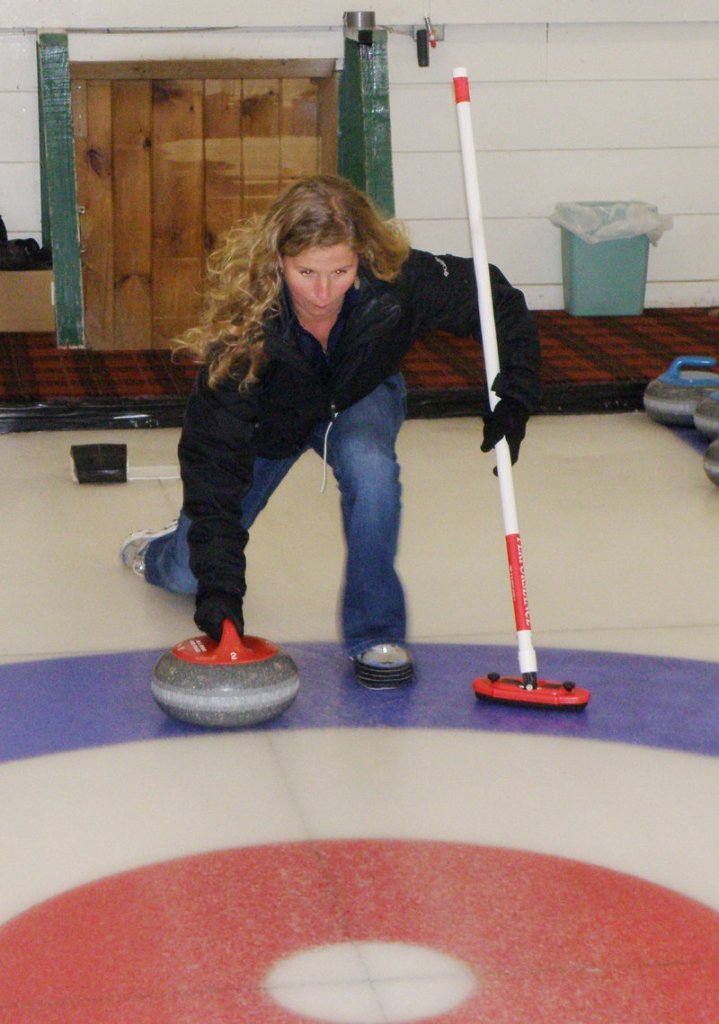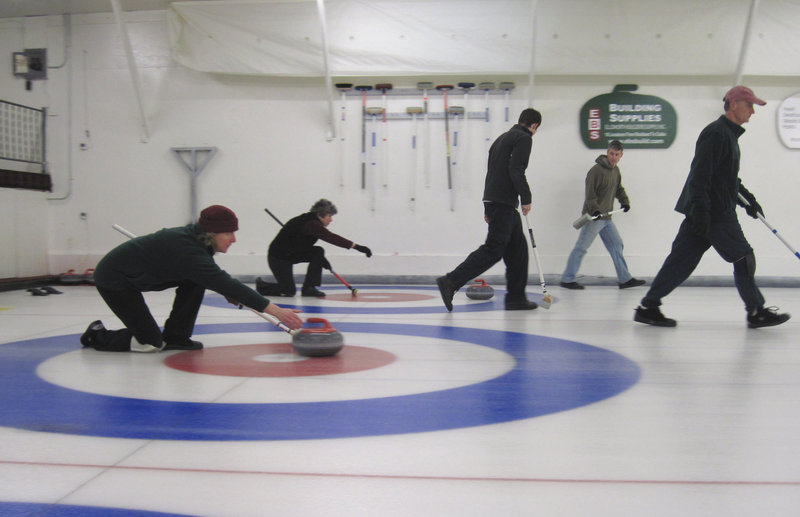People in glass houses shouldn’t throw stones. People in brick houses who have neighbors with a lot of expensive windows probably shouldn’t throw stones either.
And while that sage advice can help guide a noble life, it doesn’t translate well down at the curling club, where throwing stones at houses is not only an acceptable practice, it’s an art form.
Curling has a history stemming back to the 1500s, but the intricacies of the game remain elusive to non-players. Meaning, for those of us unfamiliar with the stone-centric sport, our understanding is typically limited to watching a few perplexing Winter Olympics finals or cracking wise with a Swiffer in the cleaning supply aisle of the grocery store.
Most of us don’t get it.
All that frenetic sweeping and the slowly sliding stone — it looks a little funny.
But a sport that’s persisted since the 16th century must have more to it than the broom. And curling does.
Maine’s neighbors to the north have taken to the game with impressive gusto; the province of Saskatchewan even boasts curling as its official sport. Despite our state’s proximity to that curling country, Maine is home to only one curling organization: the Belfast Curling Club.
Established in 1959 with a little help from fellow curlers in nearby New Brunswick, the club has a current membership of more than 100 — some driving in from Waterville, Bar Harbor, Waldoboro or farther to participate in league games and bonspiels (that’s “curling tournaments” for we novices).
Belfast Curling Club members Sue and Bob Wieluns were kind enough to meet me recently for an on-ice tutorial, where I learned simply staying upright on the slippery surface was a feat.
There are special curling shoes for those who choose to wear them, but a pair of regular sneakers suffices, too, so long as they aren’t worn in from outside, where they’re likely to have picked up dirt and other bits that will end up on the ice. You don’t want to mess with the ice.
Back in 16th-century Scotland, a frozen pond would do. But these days, curlers are particular about their ice. It needs to be level, clean and maintained at the right temperature. There’s no Zamboni. Instead, water is sprayed on the surface to pebble it. The pebbling is what enables the stones to slide easily across the ice and what makes the stones curl (or move away from a straight line).
The clubhouse boasts a wide window overlooking three curling sheets, or courts, which seemed to wake up from a long, cold hibernation after Bob Wieluns flicked a switch and the overhead fluorescent lights flickered on.
The specifications for a curling sheet are defined by the World Curling Federation: 146 to 150 feet long and 14.5 to 16.5 feet wide.
Before we got down to curling business, Bob reached out his hand. Games always start and end with opposing teams shaking hands, he said. And you say to each other, “Good curling.”
So we shook and wished each other good curling.
On the ice, Bob used his broom to point out the large bull’s eye, known in curling terms as the “house,” at the sheet’s end. His broom hovered over the line dissecting the house — the “tee line” — and the line running down the center of the sheet, aptly called the “centre line.”
Terminology is easy. Actually delivering the stone those 120-odd feet to the house at the opposite end was a whole other matter.
Experienced curlers make it look easy. Scratch that. They make it look downright elegant, with a fluid push off from the starting block and a graceful, sliding lunge toward the hog line, where the curler and stone part ways.
Sue Wieluns illustrated the move, leaning on her broom for extra support and delivering the stone repeatedly with seemingly little effort. So I slipped on a slider (which fits over a curler’s shoe and looks like a flip flop for someone with no toes. It helps the lead foot slide easily on the ice), clutched a broom for support and readied myself to push off from the starting block.
The thing is, ice is slippery, especially when there’s a slider on your foot. Mastering the art of not falling down is half the battle.
I lost my balance during my first few attempts, my arms flailing in a protective spasm. A couple of tries later and my sliding lunge grew steadier, but my stone delivery was, to put it bluntly, half-iced: I could only send it halfway across the ice. It’s force faded to a dead stop in the middle of the sheet.
In my defense, a granite curling stone weighs 42 pounds. That’s about the same weight as a 3-year-old child. The difference is, of course, I could probably coax a 3-year-old to walk the rest of the way.
Practicing next in the role of sweeper (the two players with the brooms), I watched as Sue’s first stone sped right past me. My reflexes had apparently succumbed to the cold. I stayed ahead of the next stone, sweeping when Bob yelled “Sweep! Sweep! Sweep!”
This was no casual pass of the broom. This was a frenetic act, more akin to cleaning an obstinate scuff mark with a squeeze mop. I broke a sweat.
Sweeping cleans and warms the ice, both of which affect the direction and distance of the stone. And yes, it looks a little funny.
But as I realized during the league games later that evening, the act of delivering a stone is not only unique to each player, but artful.
Teams are made up of four people, all of whom take turns throwing a stone. The first is known as the lead, the second, as the second, the third as the vice and the fourth as the skip. The skip controls the team’s strategy and he or she hangs out near the house, giving direction to the thrower and sweepers. And the skip yells things like “Sweep!” or “Clean!” or “Hurry hard!”
With multiple teams playing simultaneously, it can be hard to distinguish one skip from another. Add in the low rumble of granite stones on pebbled ice — and the hard clank of stones into each other — and curling can get loud.
Each team throws eight stones in an end. The team with a stone closest to the tee line, or center of the target, gets the point. They earn additional points for every stone in closer proximity to the tee line than any of the opponents’ stones.
Eight ends make up a game, and the team with the most points is the winner.
But win or lose, curling games always start just as they began: with opposing teams meeting on the ice to shake each other’s hands and say, “Good curling.”
Staff Writer Shannon Bryan can be contacted at 791-6333 or at:
sbryan@mainetoday.com
Send questions/comments to the editors.




Success. Please wait for the page to reload. If the page does not reload within 5 seconds, please refresh the page.
Enter your email and password to access comments.
Hi, to comment on stories you must . This profile is in addition to your subscription and website login.
Already have a commenting profile? .
Invalid username/password.
Please check your email to confirm and complete your registration.
Only subscribers are eligible to post comments. Please subscribe or login first for digital access. Here’s why.
Use the form below to reset your password. When you've submitted your account email, we will send an email with a reset code.